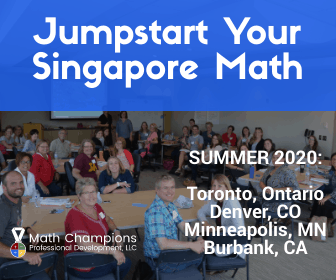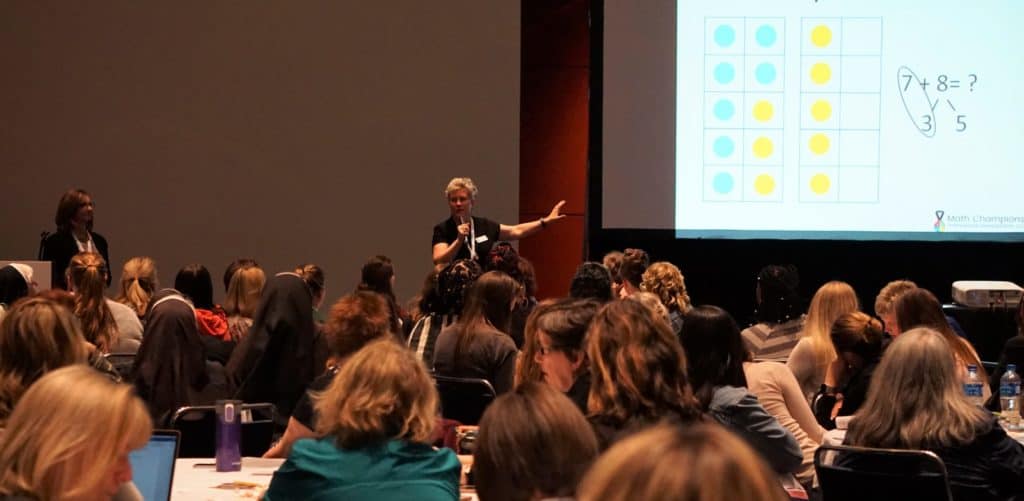Survey – How do you like to learn online?
Word Problem Wednesday – Printer and Laptops

Our new problem is from the soon-to-be-published Dimensions Math 5A textbook. The word problem is from Chapter 1 after lessons on mental math.
You’ll want to draw a bar model, but then see if you can complete the computations mentally!
A library bought a printer and 5 laptops that cost $6,000 altogether. Each laptop cost $420 more than each printer. How much does the printer cost?
Our previous Word Problem Wednesday problem came from an article in the Daily Express, a UK newspaper: This is the maths puzzle that is baffling everyone.
Here’s one solution:
One parent who homeschools had her 7-year-old son take on the challenge. Enjoy the two-part video. I think the best part is in Pt. 2 when the son says to his mom: “Processing, please do not interrupt.”
The Impact of Singapore Math at MPA
[Note: I’ve enjoyed working with Mounds Park Academy (MPA) in Saint Paul, Minnesota, since 2014. For the last three years, MPA has generously hosted our annual Jumpstart Your Singapore Math Instruction workshops.]

I was thrilled to read a January 9, 2020, blog post, “The Impact of Singapore Math at MPA,” written by Lower School Director Renee Wright. It is a brief, but thorough, overview that anyone considering a Singapore program should read.
Renee recounts some of the many reasons the school chose to adopt
a Singapore program in kindergarten through fifth grade six years ago,
including:
Singapore Math meets the needs of all learners, provides
extra practice and support for students when necessary, and is inherently
challenging for the advanced math student.
To illustrate her point, Renee invites readers to consider a word
problem assigned to fourth graders:
Mrs.
Wright, Dr. Hudson, and Ms. Tesdahl all wrapped lots of presents over the holidays.
Mrs. Wright wrapped four times as many as Dr. Hudson (remember,
she has grandchildren!), and Ms. Tesdahl wrapped 3 more than half as many
as Mrs. Wright. Together they wrapped 31 presents. How many presents did
Dr. Hudson wrap?
She notes that this is a challenging problem for Lower School students and maybe even readers. But:
Believe it or not, fourth-graders at Mounds Park Academy approached this problem with confidence and were successful in finding the solution.
Renee includes data to document student success:
We can carefully examine the longitudinal data and impact of
Singapore Math. One way is to review ACT Aspire assessment data collected over
the past several years to determine if our students’ scores have shown
improvement. Our student data has been compared to national percentiles and
independent school benchmarks and it shows that our students have made steady
gains in math concepts and usage.
She also includes anecdotal evidence from several teachers, including: Renette Stinson and Shelley Steingraeber (third grade); Deedee Stacy and Yamini Kimmerle (fourth grade); and Chris Peterson (fifth grade). Deedee and Yamini said:
Singapore Math is designed to give students an extremely well
developed mathematical foundation, and to challenge them daily to apply
mathematical concepts in new situations. Our students at MPA love to learn, and
Singapore Math makes that happen!
And what did students say?
…third graders [said] that Singapore Math is challenging, but
fun! One student identified the mental math emphasis as something that helps
him use math every single day. Another student said she used to hate math but
now she loves it because Singapore Math makes sense.
Finally, Renee offers her reflections:
Today, as an administrator looking at the data, hearing from
the teachers, and feeling the enthusiasm for math from our students, I know
that adopting Singapore Math was the right decision. It has served our students
well and is aligned with the college preparatory nature and foundational
mission of our school. I am so proud of the time, attention, and effort our
teachers have put into teaching the Singapore curriculum. I acknowledge and
celebrate the math success our students have had daily in the classroom due to
the Singapore Math curriculum and feel confident they are ready for their
future journey of higher level math.
Graphing the Holidays
Teaching between Thanksgiving and the winter break can be a challenge. How do you keep your students engaged in meaningful math learning while embracing the season? Introducing graphing and data analysis might just be the answer.
Imagine starting your day in first grade with a question about favorite holiday treats. Students can answer the question and instantly you have meaningful data that can be organized into a tally chart, picture graph, or bar graph for students to analyze. Or, students can build a bar graph with post-it notes as they make their choices. Then, spend some time analyzing the results.
Ask 5th graders if they traveled over Thanksgiving break. If so, how far? Now use this data to find mean, median, and mode, or to create a histogram for students to analyze. Or, chart the temperatures over the course of a couple of weeks and use this data to create a line graph.
Third and fourth graders could tally the number of candles in their homes for the holidays and use this data to create a line plot. Fourth graders can use their line plots to explore finding the median.
Planning a holiday party? Survey the students on what should be served and what activities should be included. Students can present the findings in a graph and use the results to determine how much and what needs to be donated or purchased to make the party a success.
The holidays are a great time to share family traditions. Why not use that information to meet some graphing and data analysis standards?
For other ideas to keep students engaged in learning read Mental Math Breaks from December 2017.

































